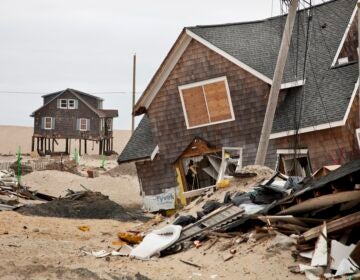Forecasters predict a busy hurricane season for 2025
NOAA said a warmer ocean is partly to blame for the above average predictions. New Jersey officials said beach preparation is key.

This GOES-16 GeoColor satellite image taken at 4:40 p.m EDT and provided by National Oceanic and Atmospheric Administration (NOAA) shows Hurricane Ernesto in the Atlantic Ocean south-southwest of Bermuda, Friday, Aug. 16, 2024. (NOAA via AP)
This story is part of the WHYY News Climate Desk, bringing you news and solutions for our changing region.
From the Poconos to the Jersey Shore to the mouth of the Delaware Bay, what do you want to know about climate change? What would you like us to cover? Get in touch.
Forecasters from the National Weather Service predict another above-average hurricane season for 2025. Predictions are for 13 to 19 named storms, meaning winds of more than 38 miles an hour. The season, which runs from June 1 through November 30, could see six to 10 of those storms developing into hurricanes, with wind speeds of at least 74 mph, and three to five reaching wind speeds of more than 110 mph.
The National Oceanic and Atmospheric Administration, which provides the report each year, warns that coastal and inland residents should prepare.
“As we witnessed last year with significant inland flooding from Hurricanes Helene and Debby, the impacts of hurricanes can reach far beyond coastal communities,” said Laura Grimm, Acting NOAA Administrator. “NOAA is critical for the delivery of early and accurate forecasts and warnings, and provides the scientific expertise needed to save lives and property.”
NOAA said a warmer ocean is partly to blame for the above-average predictions. Warm waters provide the fuel for developing storms. So as climate change heats up the ocean, storms can develop more quickly, dump more water, and pack a larger punch with high wind speeds.
“It’s really important that we maintain our commitment to preparing our beaches,” said Jon Miller, a professor at Stevens Institute of Technology and author of New Jersey’s annual “State of the Shore” report. “[In] many locations, we have nice, robust dunes as well. Those are the things that protect us from these storms. That’s our first line of defense.”
New Jersey officials also use the Tropical Meteorology Project at Colorado State University as a guide, which this year puts the probability of a hurricane impacting the Garden State, or coming within 50 miles of its coastline, at 9%. The project puts the probability of a major hurricane hitting the state at 1%.
“Depending on your perspective, these numbers might seem low,” said Miller. “But it’s important to keep in mind that, storms like Hurricane Sandy and Hurricane Ida, that caused major impacts in the state of New Jersey, before they impacted the coast, actually were downgraded, so they were not even named a hurricane when they hit the coast,”
In 2021, remnants of Hurricane Ida also caused devastating floods inland in the Philadelphia region, where five people died.
While the region escaped hits from major storms in 2024, other areas of the country were pummeled by the deadly Helene, Beryl, and Milton. Although NOAA also predicted 2024 as above average, the agency says 2025 is not likely to be as bad.
Despite widespread cuts of federal workers, including at NOAA, Grimm said the hurricane center is fully staffed. But former NOAA officials told NPR the agency is reeling from DOGE cuts.
“I don’t think the current situation is sustainable,” former National Weather Service meteorologist Brian LaMarre told NPR’s Weekend Edition. “Because burnout can happen very easily if there are a high frequency of high-impact weather events.”

Get daily updates from WHYY News!
WHYY is your source for fact-based, in-depth journalism and information. As a nonprofit organization, we rely on financial support from readers like you. Please give today.






